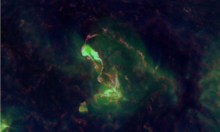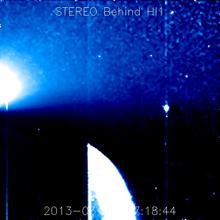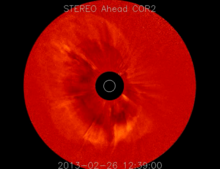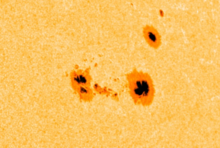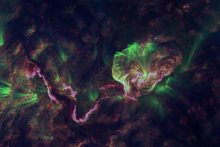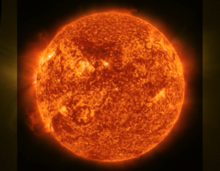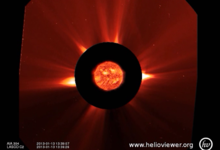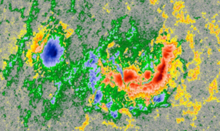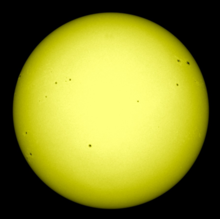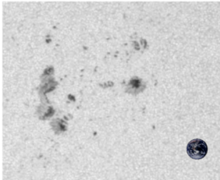news
Submitted on 2013-03-22
The Sun took a good aim at Earth this week.
Submitted on 2013-03-14
From the darkness of outer space, comet Pan-STARRS has come to pay us a one-time visit before receding again into the coldness of oblivion.
The comet, officially designated as C/2011 L4, was discovered in June 2011 by the Pan-STARRS telescope on Hawaii when it was still over 1 billion kilometers away from the Sun. Last Sunday, on 10 March, the comet was closer to our home star than the planet Mercury.
|
Submitted on 2013-03-07
During the first two months of 2013, quite a few Coronal Mass Ejections (CMEs) were visible. As an example, this movie shows the CME-activity from 23 till 28 February. The 10 most interesting events were numbered and are discussed below.
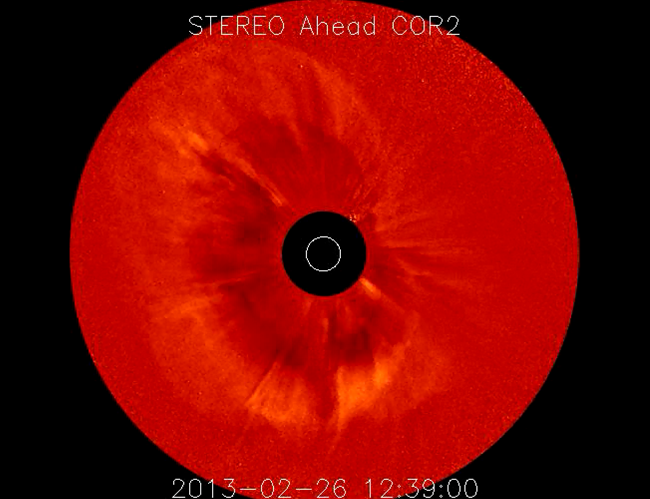
Submitted on 2013-03-01
On 18 February, a sunspot group quickly developed to the southeast (bottom left) of NOAA 1671. According to the daily NOAA reports, fresh NOAA 1678 already reached its maximum sunspot area on 21 February, being nearly three times as large as the total area of the planet Earth.
|
Submitted on 2013-02-14
On 6 February, in the time span of just a few hours, an interesting pair of eruptive events occurred on the Sun of which it was difficult to say if they were related or not. Surely, there were two flares and two coronal mass ejections (CMEs), but their timings and outlook hinted to some magnetic commonality.
The protagonists were NOAA 1667, a simple and relatively small sunspot group in the northern hemisphere, and a 200.000 km long but not very impressive filament about 10°-15° degrees to the east ("left") of this sunspot group.
Submitted on 2013-02-07
An interesting region in the solar corona appeared over the southeast solar limb starting 1 February.
|
Submitted on 2013-01-25
In the Star Trek series, the Romulan empire disposes of an advanced technology that makes their spacecraft invisible. Using this stealth technology, they sneak up behind their unsuspecting enemies, suddenly revealing themselves and blowing the enemy spacecraft to smithereens.
A Coronal Mass Ejection (CME) used its own cloaking device to wreak geomagnetic havoc last Thursday, 17 January.
|
Submitted on 2013-01-18
Active region NOAA 1654 appeared on 8 January at the northeast solar limb and quickly became the dominant sunspot group on the visible solar surface. On 11 January, its sunspot area equaled about 7 times the area of the Earth, and by 13 January its length was almost 19 Earth diameters. The leading spot was complex and changed its shape impressively, as can be seen in this movie covering the period from 10 January (noon) till 12 January (noon). |
|
Submitted on 2013-01-11
The SIDC sunspot bulletin for December 2012 reported a monthly provisional international sunspot number of only 40.8. That is the lowest since February 2012 (32.9). Solar flare activity was in proportion, with no medium flares (M-class) and several days with not even small flares (C-class).
|
Submitted on 2013-01-04
July 2012 was one of the most active months so far this solar cycle, producing numerous medium and strong solar flares. Unfortunately, since then, solar flare activity has not been particularly exciting. In December, things went from bad to worse, with only a few dozen small ("C") flares and no medium ("M") flares at all. The previous month with no M-flares was December 2010. Also, the last M-flare dates back to 28 November 2012 (M2 in NOAA 1620), and the last extreme flare (X-class) occurred on 23 October 2012 (X1 in NOAA 1598). It seems ages ago!
Pages
Zircon - This is a contributing Drupal Theme
Design by
WeebPal.

